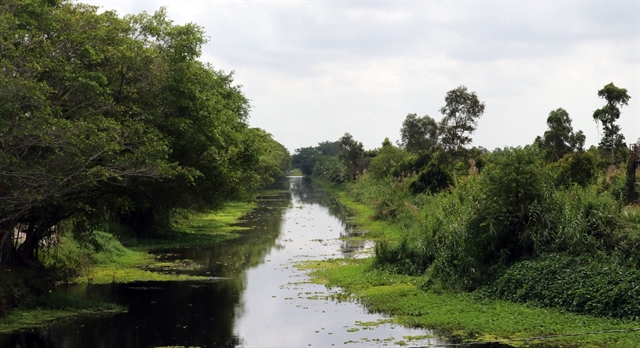 Environment
Environment


|
| A canal holds water just in case of forest fires in the U Minh Thượng National Park in Kiên Giang Province. – VNA/VNS Photo Lê Huy Hải |
HCM CITY – All forests south of the Hậu River in the Cửu Long (Mekong) Delta have been facing the threat of fire since the middle of this month, and any fire would spread very quickly because of the heat and low humidity, local authorities have warned.
The region comprises An Giang, Bạc Liêu, Cà Mau, Kiên Giang, Sóc Trăng, and Hậu Giang provinces.
In Cà Mau, more than 43,580ha of forests in the U Minh Hạ National Park, Hòn Khoai and Hòn Chuối islands face the fourth and fifth fire warning levels.
If the current weather continues, the warning level for all forests in U Minh Hạ, Hòn Khoai and Hòn Chuối islands will rise to five, the highest, according to the province Forest Protection Sub-department.
In An Giang, the threat is at level five for 7,000ha of its 17,000ha of forests, mostly in Thoại Sơn, Tri Tôn and Tịnh Biên districts and Châu Đốc City, according to the Forest Protection Sub-department.
Early this month a fire damaged six hectares of forest on Cấm Mountain in Tịnh Biên District.
Kiên Giang Province has had six forest fires caused by people burning fields since the beginning of the dry season, which damaged dozens of hectares.
It has more than 41,500ha facing a high threat of fires, according to its Department of Agriculture and Rural Development.
Hoàng Văn Tuấn, deputy director of the department, said the threat would continue to escalate because of the lack of water and heat.
All forests on Phú Quốc Island face warning level five, he said, adding that the dry sedge fields in Giang Thành District are susceptible to fire.
Before the dry season began authorities in the delta, which comprises Cần Thơ City and 12 provinces, took several measures like buying firefighting facilities and storing water in forests. They also made fire breaks in forests, built more watch towers and closed down forests with high warning levels.
An Giang has a number of plans to protect forests. Its rangers and communes have disseminated information about forest fire prevention and control and have installed firefighting facilities.
Trương Minh Hùng, deputy head of its Forest Protection Sub-department, said: “The sub-department … regularly monitors forest fire - prone areas.”
Cà Mau Province has 337 officials working around the clock in forests and mobilised nearly 2,000 members of the public for firefighting.
Lê Văn Hải, head of its Forest Protection Sub-department, said the province had built dams and closed sluices to store water in forests.
It had organised training courses in preventing and controlling forest fires for forest owners, bought more firefighting facilities and upgraded and built new watch towers, he added.
Forest development
The delta has 347,000ha of mangrove forests, cajuput forests, bird sanctuaries, and nature reserves. The forests play an important role in the delta’s socio-economic development, ecology and tourism.
According to Trần Anh Thư, deputy chairman of the An Giang People’s Committee, the province’s forests are invaluable since they are linked to pilgrimages.
Tourism sites on Cấm, Sam, Cô Tô, and Tượng Mountains and in the Trà Sư cajuput forest attract a large number of visitors.
To protect forests, delta authorities have allocated large areas to local residents for harvesting. This has both helped forests to develop and locals to earn a living and an incentive to protect them.
Trần Văn Lùn, who has received 4.8ha in Kiên Giang’s An Minh District, said the forest provided him with his livelihood.
He earns around VNĐ60 million (US$2,600) a year from harvesting wood, fish and crops he grows in the forest.
The delta provinces have afforested coastal areas in recent years to cope with climate change and prevent erosion.
Kiên Giang is carrying out afforestation in 2016-20 to develop mangrove forests.
Nguyễn Văn Tâm, director of its Department of Agriculture and Rural Development, said when the projects are completed, they would help mitigate coastal erosion and improve people’s lives. – VNS




